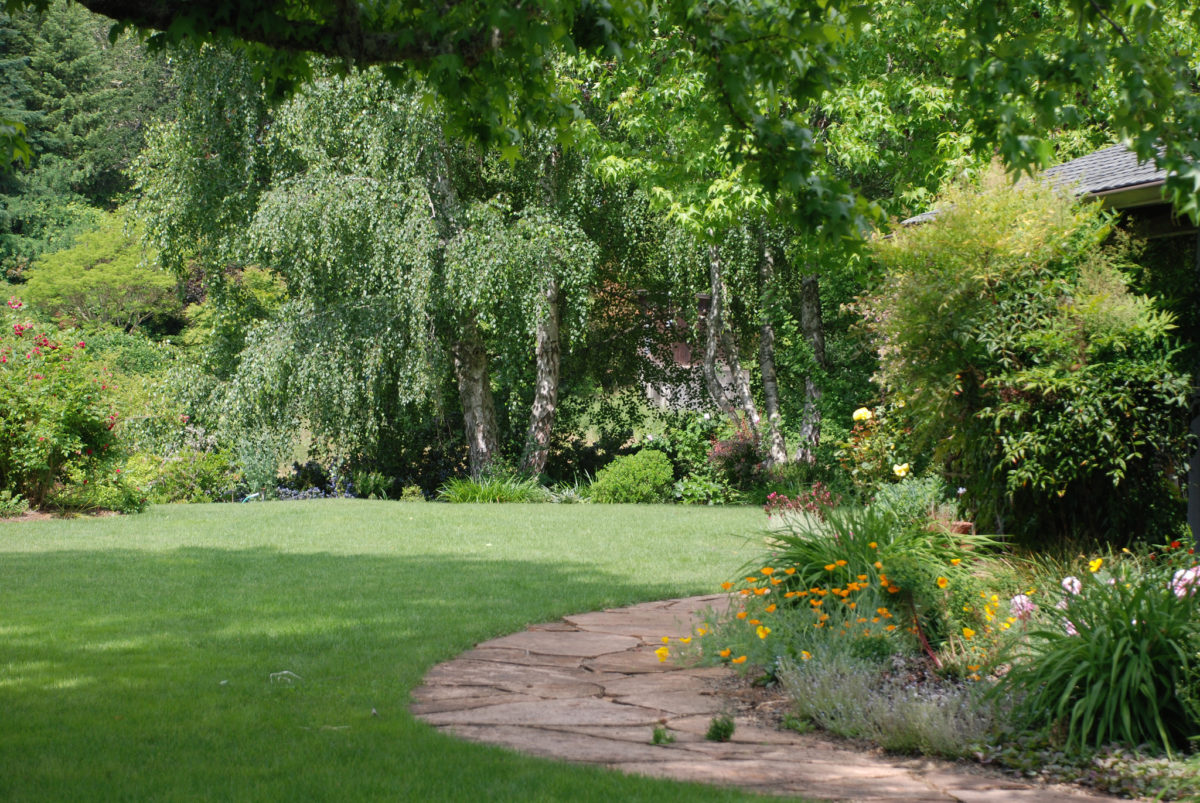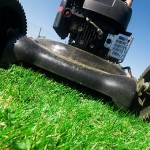
Lawns evolve every year. Just because a homeowner seeds their lawn with a typical seed mix consisting of one or two grass species (typically Kentucky bluegrass and perennial ryegrass) doesn’t mean that’s going to be the same grass types that compose the lawn years down the road.
Over time, a lawn will incorporate a total of three or four species of grass into the mix that are naturally adapted into the Oregon climate. This new mix of grass types is referred to as the “climax lawn”.
Climax lawns generally consist of bentgrasses (highland, colonial, and creeping) and bluegrass (annual and roughstalk). This is a natural process and usually ends with a lawn that’s well adapted to the surrounding habitat.
If the homeowner (you) desires a healthy and vibrant lawn then mowing, irrigating, fertilizing, and dethatching should all be top priorities.
Mowing: Just do it
Photo: Flickr / rickpilot_2000
If mowing is the only lawn maintenance task that you care to do then the least you can do to achieve a more attractive lawn is to do this correctly. Obviously, lawn mowing is the core lawn maintenance chore on the to-do list. Mowing is make or break.
During the peak growing season in the spring, it’s a good idea to mow the lawn 4-6 times a month. I know, six sounds like a lot! But remember, it’s better to mow the lawn more often and cut less off at a time than to mow the lawn once every couple of weeks and chop off the amount that you’re leaving.
The lawn mowing golden rule: never remove more ⅓ of the grass blade at a time.
Mowing more frequently and at the correct height does more than just create a healthier lawn, it’s also easier on you! Yes, these two tips will help you create a healthy, dense, vigorous turf with fewer maintenance problems but it’s also a huge time saver!
Mowing more often means being able to recycle the grass clippings back into the lawn, longer lawn mower life, and it’s always a good sweat!
Perennial ryegrass, fine fescue, tall fescue, and Kentucky bluegrass should all be mowed between 1 ½ and 2 inches.
Bentgrass (alone or in a mixture), annual bleugrass, and roughstalk bluegrass should all be mowed between ½ and 1 inch.
Watering: How much and how often?
In contrast to lawn mowing, watering more but less frequently is the way to handle your lawn watering. Watering twice per week (3 to 4 days in between) and making sure that each watering achieves between ½ – ¾ inches to crucial for proper lawn maintenance.
BUT if a healthy and vigorous lawn isn’t your priority, once every two weeks will suffice.
Between May and October, irrigating the lawn is necessary in order for it to thrive. Specifically the months between June and August your lawn will need the most attention. Living in Oregon means that your lawn is most likely a cool-season grass type. This means that your lawn is more sensitive to the warm summer heat than someone who lives Texas.
So as a result, during the summer heat it’s a good idea to lay the water on and make sure that it’s adequately soaking through to the root zone.
Another thing to note is that overwatering the lawn can cause as much damage as not watering at all. A good way to check the soil moisture is by penetrating a 6-inch screwdriver into the soil. If it punctures and penetrates down six inches easily then your lawn may not need to be watered.
Most sprinkler zones will only need to run 15-20 minutes to achieve the desired amount of water. But before you set it and forget it, run your sprinkler system and watch each sprinkler zone. You’re looking for water runoff, which is wasteful and harmful to the lawn. Once you start to see the water literally run off the ground, write a note for how long that zone ran. Then calibrate that zone to run for the allotted time for each lawn watering.
The best lawn watering schedule will stem from the soil type. Clay soil is harder for water to penetrate so your sprinkler system may need to run zones in shorter bursts than a lawn composed with sandy soil.
Fertilizing: Don’t overdo it
Fertilization could honestly take up it’s on entire post. And we will probably end up writing that for our readers.
For now, just remember to fertilizer once or twice per year and common fertilizer mixtures containing nitrogen, phosphorous, and potassium are 24-4-16 and 12-4-8 (N-P-K).
Good times to fertilize are during the spring and fall. The summer and winter typically achieve very little results.
Use a spreader and make sure to distribute the fertilizer evenly across the lawn. Don’t apply more fertilizer to “weak” spots as this could have the opposite desired effect. Also, make sure that all grass clippings are removed so that the fertilizer can actually get down to the soil.
If you have any more questions, my best advice is to read the bag. The bag will have specs and instructions for applying the proper amount. Just make sure to purchase one of N-P-K’s listed above.
Dethatching: Is your lawn being suffocated?
Thatch can cause pesky problems for lawns. Thatch is a tight layer of grass stems and roots (alive and dead) that forms between the soil surface and the foliage. The significant problem with thatch build up is that the roots just grow into the thatch rather than extending into the ground.
Also, having that dense layer of thatch will restrict adequate amounts of sunlight, air, and water from reaching the root system.
Other problems that this can cause are reduced vigor, poor (pale) color, and dry spots across the lawn.
Using a vertical mower, aeroblade, verticutter, or dethatcher is the best way to combat this. A steel rake also proves to get the job done, though it will take much longer.
A similar problem is having too much soil compaction. This creates similar problems to thatch build up and is best tackled by lawn aeration.
The optimum time to dethatch or aerate your lawn is during the spring right before peak growing season.
Have questions about lawn care? Visit our Portland, OR lawn page or share your thoughts in the comments section below.





